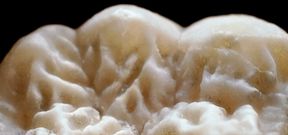Snowflakes hold the secret to how tooth enamel is formed

Physicists and mathematicians have long used the so-called Stefan problem to explain how crystals such as snowflakes take their shape. Now, researchers from Aalto University and the University of Helsinki have adapted the same principle to explain how enamel is distributed over teeth. The newly published work helps to explain why even closely-related species – such as humans and orangutans – have very different looking teeth.
Tooth enamel matrix is soft at first, but quickly hardens into the most mineralized and toughest part of the mammalian body. As enamel cannot be repaired or remodelled, its growth is a critical step in tooth formation. It's the durability of enamel that makes teeth capable of lasting for such a long time and why they are so plentiful in the fossil record.
The researchers propose that differences in enamel thickness are regulated by the nutrient diffusion rate, i.e. the rate that individual regions on a crown receive the required nutrients and substances needed to make the enamel.
Starting with a model that is used to simulate snowflake formation – the Stefan problem – the researchers built a new model that mimics the formation of the enamel matrix.
"Whereas enamel is not obviously as intriguingly shaped as snowflakes, it is interesting that the same physical principles can account for the increase in complexity in both systems," says Teemu Häkkinen from Aalto University.
Enamel has a long history in paleontological and medical research, and the new model can be used to investigate both evolutionary differences between species, and medical defects in enamel formation.
Starting with CT-images of real teeth from which enamel was digitally removed, the enamel matrix was applied to underlying dentin surfaces using a computer simulation. Only when simulating the matrix secretion as a diffusion-limited process were the researchers able to make the subtle enamel features found on a human molar.
In contrast to humans, orangutan molar teeth have complex ridges and grooves that could be simulated by lowering the diffusion rate of enamel-forming nutrients even further. Thus, orangutans, which eat hard foods such as unripe fruits and bark, may have evolved their wrinkly enamel with a relatively simple developmental change.
In addition to human and orangutan teeth, the researchers investigated enamel matrix growth in images of pig molars at the European Synchrotron Radiation Facility (ESRF). Synchrotron images reveal growth lines that provide a record of enamel matrix growth, much like tree rings show the growth of the tree. In addition to the final enamel surface, the diffusion-limited simulations reproduced these enamel growth lines.
"There are huge amounts of different data available on enamel, and now we have the tools of physicists to make testable predictions," says Academy Professor Jukka Jernvall from the Institute of Biotechnology, University of Helsinki.
The research was a collaboration between Aalto University and the University of Helsinki.
Bibliographical information:
Häkkinen TJ, Sova SS, Corfe IJ, Tjäderhane L, Hannukainen A, Jernvall J (2019) Modeling enamel matrix secretion in mammalian teeth. PLoS Comput Biol 15(5): e1007058. https:// doi.org/10.1371/journal.pcbi.1007058
Contact information:
Teemu Häkkinen
Doctoral student
Aalto University
[email protected]
Jukka Jernvall
[email protected]
Tel. +358 40 740 3478
Read more news

DeployAI Partners Gather for Heart Beat Meeting in Helsinki
The European DeployAI project's partners gathered for the Heart Beat meeting hosted by Aalto University Executive Education in Helsinki.
Get to know us: Associate Professor Maria Sammalkorpi
Sammalkorpi received her doctorate from Helsinki University of Technology 2004. After her defence, she has worked as a researcher at the Universities of Princeton, Yale and Aalto.
Aalto computer scientists in ICML 2024
Computer scientists in ICML 2024